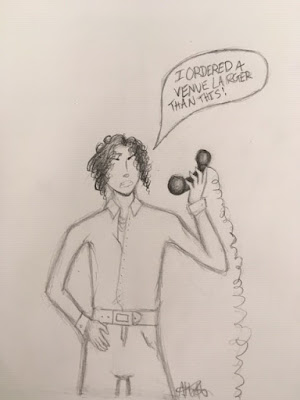As animation students, our project revolves around bringing
animation into a more physical dimension by using plastics. We plan to do this
by producing a 3D printed zoetrope using characters modelled and animated
within the computer.
What is a Zoetrope?
 |
| Paper Zoetrope - Source: http://www.cutoutfoldup.com |
‘A zoetrope is one of several pre-film animation devices that produce the illusion of motion by displaying a sequence of drawings or photographs showing progressive phases of that motion.’
Traditionally,
zoetropes are 2D animations akin to flip books, in that you view the animation
through small slits in a spinning device. However, thanks to modern plastic
technology our project will consist of several 3D printed models, spinning on a
base with a flickering light to create the illusion of movement. We plan to
illustrate chaos within the piece, by combing multiple characters undertaking
their frenetic actions at the same time.
 |
| Concept model of Zoetrope base by Ian House |
 |
| Conceptual idea |
Who is working on this project?
We are a team of around ten 2nd year Animation Production students from the CG pathway of our course. This project was initially pitched to us by our lecturer Ian House, as an extra project to assist with the learning of CG, and as a way of showcasing animation to those outside of the course.
We assigned roles in order to treat the project like any
other animation production. The main roles are as follows:
·
Director: Merlin Voss
·
Producer: Jonny Strutt
·
Co-Producer: Marie Ogunkolade
·
Co-Director: Calum Avery
·
Supervising Lecturer: Ian House
Initial Designs of the Characters
We began by developing the characters that we would be
modelling. We had to keep in mind the simplification of the design for ease of
modelling, as well as for animating and printing. The characters were based on previous projects, and these will be developed further throughout this project - predominantly
being brought together and informed by the MoDiP collection, whether it be
references, design ideas, or miniature poly versions of objects brought to
life within the scene.
 |
| Alien by Ciara and Prince by Mitchell |
 |
| Ringmaster by Marie and Prince by Merlin |
Planning the Animation
Here I have shown thumbnails of the early stages of
developing the animations. As well as the moving characters, we could perhaps include morphing object animations, to add to the overall chaos of the scene.
Looking Forward
Our first job going forward, is to get the roster of characters modelled and rigged using Maya software. Beyond that we will be making basic 2D animated tests, and then transferring those animations to 3D.
Written by Merlin Voss
Animation Team:
Merlin Voss
Jonny Strutt
Marie Ogunkolade






















